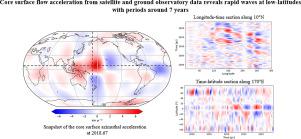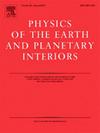用25年卫星长期变化数据探测低纬度外核表面波
IF 1.9
3区 地球科学
Q2 GEOCHEMISTRY & GEOPHYSICS
引用次数: 0
摘要
地球液态外核的流体运动产生了大部分地磁场,其时间在一年或更长时间尺度上变化,即长期变化(SV)。来自Ørsted、CHAMP、CryoSat-2和Swarm卫星任务的数据,以及来自地面观测站的数据,结合在一起,产生了从1997年底到2023年初的SV数据集。假设岩心表面流体速度为纯平流,假设主场由混沌-7.16场模型指定,对这些随时间变化的SV数据进行反演。反演在时间和空间上都是正则化的。随着时间的推移,各个时代之间的速度差被最小化了。在太空中,小规模速度结构受到惩罚。然后从连续时期的速度差计算出流动加速度。在低纬度地区,方位加速度的时间-经度图显示出倾斜的特征,这被解释为传播波的特征。观测到的波同时向东和向西传播,传播速度约为1700公里/年,这与先前对快芯波的推断一致。功率谱密度图显示,能量集中在周期为6-7年的模态上,方位角波数为- 5、- 2和2,其中负波数表示向西运动。向西传播的波比向东传播的波有更高的能量含量。最后,我们发现了间歇性的低纬度驻波,它与最近赤道地磁震动的时间相吻合,与其他研究中对磁科里奥利波和阿尔夫海姆波的推断一致。本文章由计算机程序翻译,如有差异,请以英文原文为准。

Detecting low-latitude outer core-surface waves with 25 years of satellite secular variation data
Fluid motion in the Earth’s liquid outer core generates most of the geomagnetic field, and its time changes over timescales of one year or longer, the secular variation (SV). Data from the satellite missions Ørsted, CHAMP, CryoSat-2 and Swarm, together with data from ground observatories, were combined to yield a SV dataset spanning from late 1997 to early 2023. These SV data were inverted for time-varying core surface fluid velocity assuming it is purely advective, with the main field specified by the CHAOS-7.16 field model. The inversion was regularised both in time and in space. In time, the difference in velocity between individual epochs was minimised. In space, small-scale velocity structures were penalised. Flow acceleration was then calculated from first differences of velocities at successive epochs. Time-longitude diagrams of azimuthal acceleration show sloping features at low latitudes, interpreted as signatures of propagating waves. Waves propagating both eastwards and westwards were observed, with propagation velocities of approximately 1700 km/yr which is in agreement with previous inferences of fast core waves. Power spectral density plots reveal that the energy is concentrated in modes with periods of 6–7 years, and azimuthal wavenumbers −5, −2 and 2, where negative wave numbers indicate westward motion. There is a higher energy content in the westward propagating waves than in those travelling eastwards. Finally, we find intermittent low-latitude standing waves, which coincide with times of recent equatorial geomagnetic jerks, consistent with inferences of magneto-Coriolis and Alfvén waves from other studies.
求助全文
通过发布文献求助,成功后即可免费获取论文全文。
去求助
来源期刊

Physics of the Earth and Planetary Interiors
地学天文-地球化学与地球物理
CiteScore
5.00
自引率
4.30%
发文量
78
审稿时长
18.5 weeks
期刊介绍:
Launched in 1968 to fill the need for an international journal in the field of planetary physics, geodesy and geophysics, Physics of the Earth and Planetary Interiors has now grown to become important reading matter for all geophysicists. It is the only journal to be entirely devoted to the physical and chemical processes of planetary interiors.
Original research papers, review articles, short communications and book reviews are all published on a regular basis; and from time to time special issues of the journal are devoted to the publication of the proceedings of symposia and congresses which the editors feel will be of particular interest to the reader.
 求助内容:
求助内容: 应助结果提醒方式:
应助结果提醒方式:


